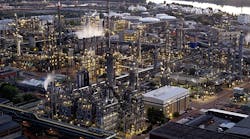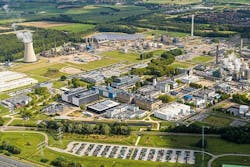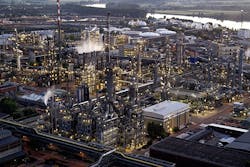Generating “green” electricity from renewable sources to replace the fossil fuels used by chemical plants presents an attractive way for operating companies to achieve their sustainability and net-carbon-zero goals. One angle companies such as BASF, Borealis, BP, Dow, Linde, LyondellBasell, SABIC, Shell and TotalEnergies (formerly Total) all are pursuing is boosting the use of such electricity in their processes. However, these efforts face myriad challenges — technical, economic and governmental.
In August 2019, BASF, Ludwigshafen, Germany; Borealis, Vienna; BP, London; LyondellBasell, Rotterdam; SABIC, Riyadh, Saudi Arabia; and TotalEnergies, Paris launched one of the first efforts, when they teamed up to form the Cracker of the Future consortium. The six companies agreed to jointly investigate the possibility of using renewable electricity instead of fossil fuels to provide heat for naphtha or gas steam crackers.
“Phase one of our work included literature and patent searches to identify the state of the art in terms of electro-heating technologies. From this, we produced a 200+ page report,” explains Walter Vermeiren, chair of the consortium and head of technology and scientific intelligence at TotalEnergies Corporate Research & Development.
Based on that report, consortium members selected five undisclosed concepts for further consideration.
Following this study phase, BASF and SABIC decided to leave the consortium, citing obligations to a pre-existing partnership on a similar topic.
Vermeiren notes that Repsol, Madrid, has since joined the consortium, with other companies expected to become members shortly.
Meanwhile, phase two of the project continues apace, with the aim of winnowing down the five concepts to one or two.
“Consortium members will then decide on which concept or concepts to pursue and make a start on the research, prototyping and design work needed,” says Vermeiren.
As part of phase two, the consortium is consulting with technology companies in the petrochemicals sector, together with those involved in electro-heating that already supply their products to energy-intensive industries such as material processing.
“There’s a lot of talk and announcements and patents being filed but, if you dig deep, you realize how much work there is still to do. For example, not even the smallest prototype is there yet and most of them are still at the drawing table to develop their heating concepts,” adds Vermeiren.
If all goes well, phase two should finish during the summer. Then work should begin in late 2021 on the research and development needed for whichever option or options get the thumbs up from consortium members. The prospective timeline includes a pilot plant in 2025 followed by a full-sized furnace demonstration plant on one of the member’s sites by 2030.
Coordinating The Initiative
The Brightlands Chemelot Campus (Figure 1), Sittard-Geleen, The Netherlands, is facilitating the effort, acting as an independent coordinator for the consortium. The level of information exchange between the consortium members is unprecedented in her experience, stresses Lia Voermans, director of innovation and strategy at the Brightlands Chemelot Campus. “It highlights what a big, big step this is in terms of how major processes will operate in the future,” she notes. High level meetings also are taking place with European Union (EU) committees and relevant national governments, all of which know about and are very interested in the project’s aims, she adds.
Figure 1. Cracker of the Future consortium may benefit from work of chemicals-related start-ups at Dutch site. Source: Brightlands Chemelot.
The EU’s deadline for net-zero greenhouse gas emissions is 2050 but consortium members already feel a sense of urgency because the complex technologies necessary likely will take at least ten years to develop from demonstration to commercial scale.
Vermeiren explains: “The process essentially involves a big furnace box with multiple reactor coils that needs heating to a high temperature for the cracking to occur. The question really is, do we provide decarbonized electricity to heat the same coils in a similar way — outside in — to how heating occurs today, or do we adopt a totally new concept such as heating from the inside? So, there’s no change from a chemical point of view because all you are doing is raising the hydrocarbons to high temperatures. However, the mechanical and hydrodynamic engineering involved in current cracker technology and the inside-heating designs couldn’t be further apart.”
In the meantime, the consortium is pursuing the EU for help with development costs, which likely will run between €30 million (≈$37 million) and €50 million (≈ $61 million) for the pilot and demonstration phases, excluding financial and in-kind contributions from the partners.
“We have a lot of different chemicals-related start-ups and pilots on the campus, who are working independently and we are in conversations with them to see if we can find different pathways to get quick results with the project,” adds Voermans.
Earlier Pact Spurs Exit
Meanwhile, expanding on the reasons behind the departure of BASF and SABIC from the consortium, Andrea Haunert, BASF’s senior global technology manager, basic petrochemicals, Ludwigshafen, says, “Some of the selected technical options would interfere with BASF’s obligations in the partnership it already had with SABIC and Linde [Dublin].”
The three previously had been investigating different concepts for using renewable electricity instead of the fossil fuel gas that typically serves for process heating and, in late March, announced a formal joint agreement to develop and demonstrate technologies for electrically heated steam-cracker furnaces.
BASF and SABIC have extensive knowhow and intellectual property in developing chemical processes as well as longstanding experience and knowledge in operating steam crackers. Linde brings intellectual property, plus expertise in developing, constructing and bringing steam-cracking furnace technologies to the market.
Commenting on the tie-up, Juergen Nowicki, executive vice president of Linde and CEO of Linde Engineering, Pullach, Germany, explains, “With this project, we are singling out a particular industrial CO2 producer. Cracking furnaces are one of the largest CO2 emission sources in the whole petrochemical value chain. This is a time-tested, optimized technology that we are now putting on a completely new footing, not in the laboratory, but on a large industrial scale. The effect this project will have is significant.”
The three partners already are breaking new ground, notes Haunert. “We have not only developed novel electrical heating concepts for steam crackers but also want to demonstrate the reliability of key components, like metallic materials and other custom-made components such as electrical connections, for use in these types of high-temperature reactors. Other key aspects are the new furnace design targeting high operating efficiency, high operating time and operating safety.”
The companies currently are evaluating construction of a multi-MW demonstration plant at Ludwigshafen, which might start up as early as 2023. Ludwigshafen was chosen for this as BASF operates two steam crackers there, while it also is the headquarters for both BASF’s carbon-management research-and-development program and its process research and chemical engineering platform (Figure 2).
Figure 2. German complex that will host demonstration plant already operates two steam crackers. Source: BASF.
“This makes it an ideal environment to drive development activities and investment in the demonstration plant, although, looking forward, the use of this new technology is not focused solely on Ludwigshafen,” adds Haunert.
While the project concentrates on cracker technology, other endothermic processes such as reforming, dry-reforming and dehydrogenations might benefit from the development as well, she points out.
Nevertheless, all of this still depends on positive funding decisions from the EU’s Innovation Fund and the German Federal Ministry for the Environment’s Decarbonization in Industry Fund. The first is a €10-billion (≈$12.2-billion) fund designed to bring clean innovative technologies to the market. The German government is providing €2 billion (≈$2.4 billion) towards the second.
“Both seem a good fit for the intended project,” notes Haunert, adding the partners won’t comment on the specific level of funding they seek.
If the project is successful, the companies plan to share relevant project experience with other European- or German-funded projects by participating in local, regional, national or EU events and conferences. They also plan to organize specific workshops and events to disseminate new results and project findings while at the same time protecting their intellectual property.
“BASF, SABIC and Linde plan to license the technology to olefin producers via Linde,” reveals Haunert.
“If funding is granted and a demonstration plant could be installed as currently planned in 2023, then we think the technology can be offered to the market for full-scale applications starting from 2027, so electric furnaces could be installed in subsequent years,” she concludes.
Broader Initiative
This technology fits into a cooperative agreement recently unveiled that promises to impact future operations at Ludwigshafen and elsewhere. In late May, BASF announced plans to work with RWE, an Essen, Germany-based energy firm, on new technologies for climate protection.
The project would rely on a new 2-GW offshore wind farm providing electricity to Ludwigshafen, where it would be used for the CO2-free production of hydrogen.
The aim is to electrify the production processes for basic chemicals that currently use fossil fuels.
Commenting on the plan, RWE CEO Markus Krebber notes the new wind farm already is at the planning stage and coupling its output to an industrial customer for use with green production technologies would be a first for Germany. “The realization of our proposal would represent a true acceleration of the expansion of renewable energies. Of course, there are still some open questions, but we want to push this forward — the faster, the better,” he adds.
One question involves the regulatory framework. For example, the partners would like to see priority being given to applications for offshore wind farms whose electricity will be used in industrial transformation processes.
Also, they insist that green electricity shouldn’t have to pay levies imposed on other electricity production to support renewable energy sources. A final cause for concern for BASF and RWE is the complete absence of any regulatory framework for CO2-free hydrogen production.
Another issue that could affect future operations of such processes is the status of nuclear power in the EU — in particular, if it is seen as “green.”
A report carried out by the European Commission’s Joint Research Center (JRC) was designed to clarify this point. A version of the report, marked “sensitive,” was leaked in March. In it, the JRC notes that analyses did not reveal any science-based evidence that nuclear energy does more harm to human health or to the environment than other electricity production technologies already included as activities supporting climate change mitigation. Further, it went on to state that recent lifecycle analyses show the impacts of nuclear energy are mostly comparable with those of hydropower and the renewables as far as non-radiological effects.
Nuclear power, if termed “green,” would open up possibilities for other ways to supply new, electrically operated chemical processes — especially for countries such as France that have a large dependence on nuclear power.
However, environmental organizations such as Greenpeace Europe insist that no list of sustainable activities should include nuclear power.
Another Joint Effort
Dow, Midland, Mich., and Shell, The Hague, The Netherlands, signed a joint development agreement in June of last year to accelerate economically feasible technologies to electrify ethylene steam crackers. The two had been collaborating prior to the announcement, led by innovation project teams in Amsterdam and Terneuzen, The Netherlands, and Texas in the United States.
However, other than the obvious aim to prove innovative process technology in the laboratory and pilot operations before scaling to commercial crackers, details remain sketchy.
Seán Ottewell is Chemical Processing's editor at large. You can email him at [email protected].



